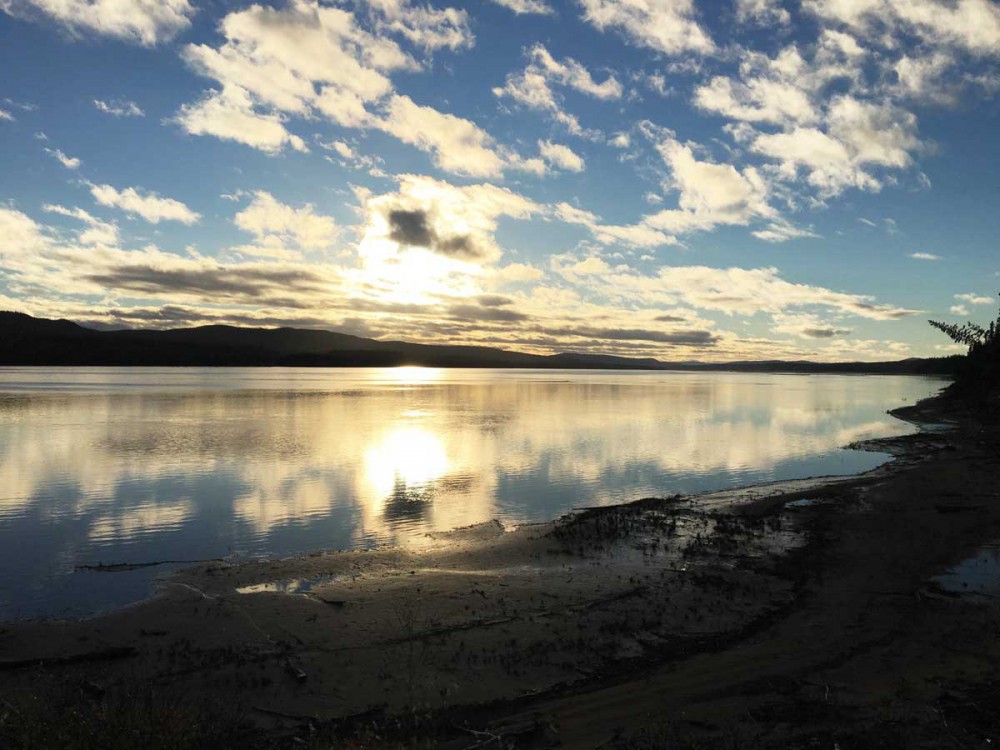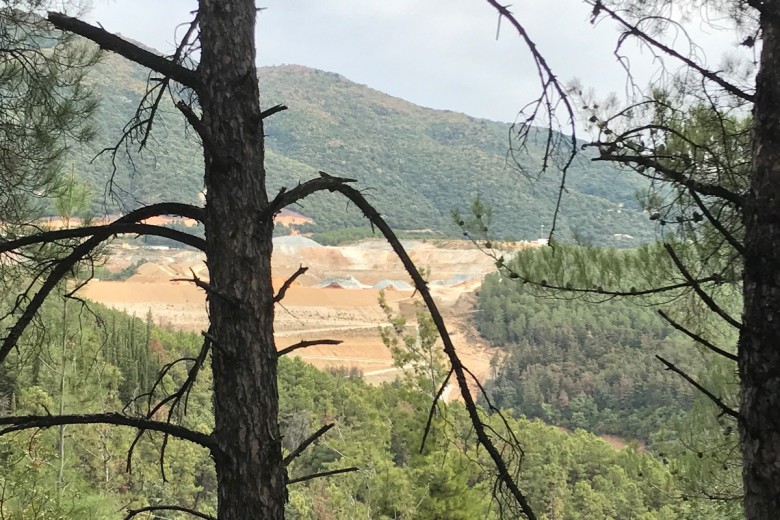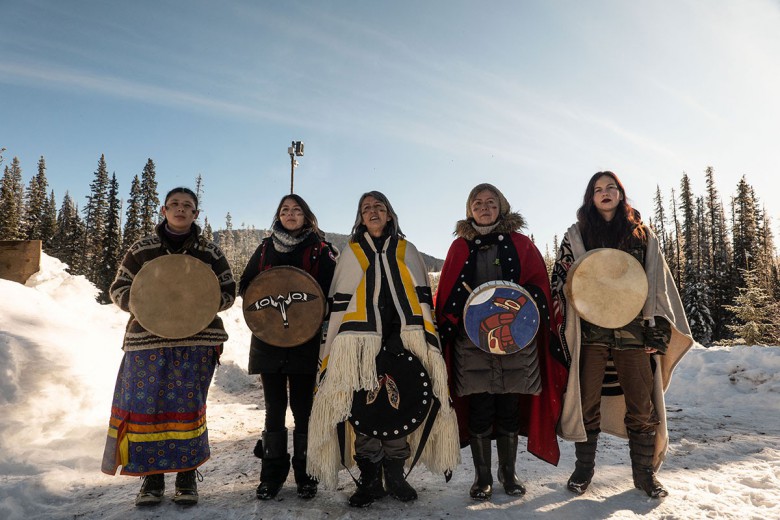On the night of October 25, 2016, behind closed doors, negotiations between three Indigenous groups and the province of Newfoundland and Labrador dragged on. After 10 hours of deliberation, the doors opened: a compromise had been reached.
At issue was the construction of a hydroelectric dam by the Crown corporation Nalcor Energy. The province, acting as both regulator and developer, had been pushing through the final stages of the widely unpopular, exorbitantly expensive Muskrat Falls hydroelectric project. Fraught with accidents and harassment of Indigenous workers, the project was billions of dollars over budget and years behind schedule. Even Nalcor’s CEO, Stan Marshall, called the project a “boondoggle” and said that starting it in the first place was a mistake, but it was too far along to stop.
While all of these elements of the project angered people across the province, it was Nalcor’s lack of proper environment-al assessment and the project’s potential danger to fish and game stocks downstream from the dam that worried people in Labrador the most. When Nalcor announced in October that the first round of flooding would happen later that month, demonstrations swelled.
A group of about 50 Labradorian demonstrators occupied the dam site, sending home hundreds of day shift workers: cement pourers, heavy-equipment operators, scaffolding workers, support staff, and others. Just days before the company had scheduled its first round of flooding, the protests prevented fuel and sewage from being transported, effectively halting the entire operation.
At the same time, three Labrador Inuit hunger strikers – Billy Gauthier, Delilah Saunders, and Jerry Kohlmeister – travelled to Ottawa to raise national awareness about Muskrat Falls and to try to convince the federal government to stop the project until the province could guarantee proper environmental mitigation.
Muskrat On The Map
Fed by the Churchill River, Muskrat Falls is located about 40 kilometres upstream from Lake Melville. A misnomer, Lake Melville is actually a long estuary that runs into the Labrador Sea. Extensive sandy beaches hug the narrow waters, and weathered mountains frame the vast shoreline forests. Since the glaciers retreated, people have been coming here for the area’s fish and game.

Comprising five communities, about 10,000 Inuit, Innu, and settlers live along the shores of Lake Melville. To this day, many Labradorians, mainly Inuit, rely on hunting and fishing here for their everyday needs. They are concerned that the runoff from the dam directly into Lake Melville will contaminate their food source with the neurotoxin methylmercury.
When pollution, largely from industry in the south, blows north and falls as precipitation, plant matter absorbs the contaminants, and over time, toxins such as mercury become sequestered in the earth. If that area floods and those contaminated plants and organic materials decompose in the water, those toxic pollutants can enter the food chain. Mercury reacts with organic materials to become methylmercury, a deadly neurotoxin that bioaccumulates as it goes up the food chain. Many large inland fish and marine mammals on which the Inuit rely, like trout and seals, could become dangerous to eat.
The Nunatsiavut government, representing the Labrador Inuit, partnered with independent researchers from Harvard University to study the potential impact of the dam on the Lake Melville environment – much of which falls within their land claim area. The environmental impact assessment that Nalcor was mandated to do by the provincial and federal governments stopped just short of encapsulating the Inuit claim area in Lake Melville, considering it “outside of the lower Churchill River watershed” and therefore unnecessary to study. The Harvard study surveyed an additional 160 kilometres, covering the entirety of Lake Melville, where people hunt and fish. Their findings suggest a much higher occurrence of methylmercury than the province found.
“In our post-flooding analysis, we calculated that exposure might double, on average,” warns Ryan Calder, doctoral candidate at Harvard University’s school of public health who works on forecasting health risks from infrastructure development. “The impacts [from the dam] are very heterogeneously distributed, so people who don’t eat anything from the Land won’t be affected at all, obviously, but some people, especially in the community of Rigolet, where people eat local food every day, sometimes several times a day … are quite highly impacted.”

Methylmercury contamination concerns extend beyond Labrador, Calder explains. Hydroelectricity already powers the majority of Canada, and 90 per cent of all potential hydroelectric sites that are currently being considered in Canada are near Indigenous communities.
“Canada’s hydro resources are still two-thirds undeveloped so Canada can, and probably will, develop this resource because so many places in Canada and the United States are looking for sources of renewable electricity,” says Calder. “Ideally we can make a screening tool to anticipate these side effects in advance, so [the study] can be a tool in the infrastructure development decision-making in the future to potentially avoid these situations.”
Hydro in Canada brought in revenue of $26 billion in 2013, with the bulk of developments in Quebec and B.C. Hydroelectric reservoirs cover over 58,000 square kilometres across the country. The largest of these is the Smallwood Reservoir in the interior of Labrador, which was built during the construction of Muskrat Falls’ predecessor, Churchill Falls.
In the 1970s, the Cree of Quebec saw their homeland transformed as the James Bay Project built one of the world’s largest networks of hydroelectric power stations, covering nearly 14,000 square kilometres. The Cree Board of Health now has safety advisories in place to identify how much fish people can eat downstream of the dams. The board warns that it takes 10 to 20 years for mercury levels to return to normal in smaller fish that eat insects, and 20 to 35 years in larger fish that eat other fish.
The type of environmental work that Newfoundland and Labrador is now considering in order to mitigate human and environmental health concerns, Calder says, should have been on the table five years ago, long before ground was ever broken on the project. He says the environmental policy is now forced to be reactive because no one had all of the environmental data before the project started.
“Nalcor said there [would] be no impacts in the downstream environment or on human health, which, by the way, the government believed. We can talk about the problems of a Crown corporation accountable to the government doing an environmental assessment evaluated by the government later, but this is what happened, and the Indigenous community downstream didn’t have tools to evaluate that claim.”
At one end of Lake Melville is the Churchill River — and Muskrat Falls — and at the other end, near the ocean, is the tiny Inuit community of Rigolet – with a population of 300. People here rely on the Land, not just to survive but also to thrive and pass on their culture and way of life from one generation to the next. Inuit culture coalesces around harvesting food and resources; teaching young people to hunt and fish connects generations and teaches respect for the environment. Mercury contamination is thus a threat to traditional food and a way of life.
Charlotte Wolfrey, a grandmother and community leader from Rigolet, was arrested by the RCMP for violating a court order which prohibited demonstrators from occupying or blocking access to the dam site. Wolfrey said she did it to ensure that nothing would prevent future generations from participating in their Inuit culture.
“Fishing in Lake Melville and catching seals is who we are,” says Wolfrey. “My grandchildren are nine, seven, and six, and they all drum and they all sing [in] Inuktitut. They eat like we eat and they live like we live; they’re out on the Land when we’re out on the Land. It’s really important for us, because our Inuit culture was deliberately hidden from us by our parents when we were growing up, because we were oppressed. If you were Inuit, you were nobody, so our parents hid that from us. I wanted to instill in my children and my grandchildren a sense of pride in who we are. I wanted them to see it’s right to stand up for what you believe in. This project has a real chance of really deteriorating or even annihilating the Inuit way of life in Rigolet, and we have to stop it.”
Using spotty Internet at the edge of cellphone range, demonstrators broadcast pictures, live-streams, tweets, and posts. Traditional mainstream media was slow to respond to this story; the most reliable source of information about the protests came from Justin Brake, editor of the online alternative newspaper The Independent, who followed the demonstrators’ every step, live-streaming them whenever possible, even as they occupied Nalcor’s construction site. For reporting on the story, Brake faces criminal charges for mischief exceeding $5,000 (the maximum penalty for which is 10 years in prison) and disobeying a court injunction. Civil and criminal charges were also laid against 27 other people who were present at the occupation. The Independent has launched a legal defence fund in March to cover Brake’s court fees.
“People argue that free press is one of the pillars of free and democratic society. If I’m being told by authorities that it’s against the law and that it is a criminal act to get that story, then unfortunately we’re missing one of those pillars of a free and democratic society,” says Brake. “There are major events happening in our country all the time that happen on private property. But does being on private property mean that the public does not have a right to know about them?”
Brake says that the RCMP’s decision to press criminal charges against him has set a dangerous precedent, prompting journalists to question whether a story is worth risking charges and possible jail time. This threat is heightened when a story, like the one at Muskrat Falls, confronts private money and infrastructure.
“That’s why we’re going to fight these charges,” says Brake. “It’s so ridiculous to have civil and criminal charges against a journalist for following a story of major public interest. It’s absurd because if you saw the coverage, which we know tens of thousands of people did, then you would know how important it was that a journalist be there to capture all of that and report on that.”
Denise Cole was in St. John’s during the demonstrations and watched events unfold through live-streams and Brake’s coverage. She says she can’t thank Brake enough for keeping her up to date with everything happening in Labrador. Cole, who wants to see the project shut down for good, led demonstrations in St. John’s against the Muskrat Falls project, broadcasting live-streams from the provincial capital. Cole says that social media was a game changer in Labrador: for the first time, geographical isolation did not hamper the political momentum.
“[Social media] breaks down barriers of geography,” says Cole. “Labrador is so isolated. Government and industry can do these megaprojects in the most remote and northern places [with] hardly anyone knowing about it, and now we have this brand new way to show the world what’s happening to us. It will put a different kind of pressure on government and industry. They can’t just come in and get away with this kind of destruction without scrutiny, without being noticed.”
As October passed, a growing group of demonstrators blockaded the entrance to the dam site, bringing construction work to a near standstill. On October 22, Nalcor’s contractors temporarily laid off many of their workers and shut down dam construction.
“There were people who I never dreamed would go to the gate to protest who came out and joined us by the hundreds,” says Kirk Lethbridge, a Southern Inuit activist. “You look to the crowds and crowds of people, you’d see Inuit, and Innu, Métis, and settlers all joined together […] I don’t know if things like that will ever line up again. I suspect they will, but it was beautiful to be a part of and beautiful to behold.”
Eventually, Lethbridge and the group of Labrador land protectors, as they called themselves, broke through the main gates of the dam area and walked the long road to the dam’s construction site.
“We had some trying times in at the dam site, but mostly it was beautiful times,” recalls Lethbridge. “The momentum of people coming together, it didn’t matter what culture, or what community, we were brothers and sisters. The Labradorians jumped out of the boxes the government kept us in. We all ran around free together, and we felt it and knew it would happen again, and it hasn’t gone away.”
As the demonstrations in Labrador continued, Gauthier, Saunders, and Kohlmeister travelled to Ottawa to lobby government and speak directly to the national media. While in Ottawa, they drafted four demands that would end their hunger strike: 1. an evidence-based approach built on peer-reviewed science to mitigate human and environmental health concerns; 2. an independent assessment on the need for any preliminary flooding and that all initial flooding would be kept to a minimum; 3. the removal of soil from the flood zone; and 4. a commitment from the federal government to ensure all regulatory and environmental concerns are addressed. Leaders of the Innu Nation, Nunatsiavut Government, and the NunatuKavut Community Council, Labrador’s three Indigenous groups, agreed to negotiate on the hunger strikers’ behalf.

The premier’s announcement that the demands would be met garnered a mixed reaction. While the hunger strikers celebrated with a meal, the demonstrators outside of the provincial capital building in St. John’s included those who were frustrated and angry that the project wouldn’t be shut down altogether. Still, both sides agree that even though the project will continue, real gains have been made.
Gauthier believes that the agreement with the province was at the very least a partial victory, and that if they are able to hold government and industry to their word, they will have set the precedent for a more environmentally responsible hydroelectric industry in Canada.
The final phase of construction at Muskrat Falls, and repairs after a long, cold Labrador winter, will begin after the spring thaw and with it, no doubt, the land protectors will return to witness the developments. The fight for Muskrat Falls has been a game changer for those fighting against resource extraction in the North. The approach to democratized media taken by Brake and the social media feeds of demonstrators swiftly broadcast the developments to those who watched around the world. The communication barriers accompanying geographic isolation were largely dismantled to share voices that would otherwise have gone unheard. The Labrador land protectors have begun to live-stream and photograph all of their events because, even though they may be far away from most people, they know that others are watching.







